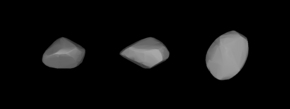73 Klytia: Difference between revisions
Appearance
Content deleted Content added
Rescuing 1 sources and tagging 0 as dead. #IABot (v1.4beta3) |
|||
| Line 29: | Line 29: | ||
| spectral_type=[[S-type asteroid|S]] |
| spectral_type=[[S-type asteroid|S]] |
||
| abs_magnitude=8.9 |
| abs_magnitude=8.9 |
||
| albedo=0.225<ref>[http://www.psi.edu/pds/resource/albedo.html Asteroid Data Sets]</ref> |
| albedo=0.225<ref>[http://www.psi.edu/pds/resource/albedo.html Asteroid Data Sets] {{webarchive|url=http://www.webcitation.org/5mqof7ROl?url=http://www.psi.edu/pds/resource/albedo.html |date=2010-01-17 }}</ref> |
||
| single_temperature=~170 [[kelvin|K]] |
| single_temperature=~170 [[kelvin|K]] |
||
}} |
}} |
||
Revision as of 08:55, 23 June 2017
 A three-dimensional model of 73 Klytia based on its light curve. | |
| Discovery | |
|---|---|
| Discovered by | Horace Parnell Tuttle |
| Discovery date | April 7, 1862 |
| Designations | |
Designation | (73) Klytia |
Named after | Clytie |
| Main belt | |
| Orbital characteristics | |
| Epoch December 31, 2006 (JD 2454100.5) | |
| Aphelion | 415.302 Gm (2.776 AU) |
| Perihelion | 382.115 Gm (2.554 AU) |
| 398.708 Gm (2.665 AU) | |
| Eccentricity | 0.042 |
| 1589.253 d (4.35 a) | |
Average orbital speed | 18.24 km/s |
| 214.253° | |
| Inclination | 2.373° |
| 7.213° | |
| 54.982° | |
| Physical characteristics | |
| Dimensions | 44.4 km[1] |
| Mass | 9.2×1016 kg |
Mean density | ? g/cm³ |
| 0.0124 m/s² | |
| 0.0235 km/s | |
| 8.297 h | |
| Albedo | 0.225[2] |
| Temperature | ~170 K |
Spectral type | S |
| 8.9 | |
73 Klytia (/ˈklɪtiə/ KLIT-ee-ə) is a main-belt asteroid. It was the second and last asteroid discovery by the prolific comet discoverer Horace Tuttle, on April 7, 1862. It is named after Clytia, who loved Apollo in Greek mythology. Of the first one hundred numbered asteroids, Klytia is the smallest.
References
- ^ "JPL Small-Body Database Browser: 73 Klytia". Jet Propulsion Laboratory.
- ^ Asteroid Data Sets Archived 2010-01-17 at WebCite
External links
- 73 Klytia at the JPL Small-Body Database
